China and Kiribati signed a Memorandum of Understanding (MOU) for cooperation on the Belt and Road Initiative (BRI) in Beijing on January 6, 2020.

Kiribati, officially Republic of Kiribati, island country in the central Pacific Ocean.
The capital and government centres are at Ambo, Bairiki, and Betio, all islets of South Tarawa in the northern Gilberts.
The name Kiribati is the local rendition of Gilberts in the Gilbertese, or I-Kiribati, language, which has 13 sounds; ti is pronounced /s/ or like the word see—thus Kiribati, pronounced "Ki-ri-bas."
Land
A few of the islands are compact with fringing reefs, but most are atolls. The largest atoll (and one of the largest in the world) is Kiritimati (Christmas) Atoll in the Line group, which has a land area of 150 square miles (388 square km) and accounts for almost half of the country's total area.
Kiritimati was used for U.S. and British nuclear weapons testing in the 1960s; it now has a large coconut plantation and fish farms as well as several satellite telemetry stations.
Banaba reaches 285 feet (87 metres) above sea level, the highest point in Kiribati. Its rich layer of phosphate was exhausted by mining from 1900 to 1979, and it is now sparsely inhabited. The rest of the atolls rise no higher than some 26 feet (8 metres), making them vulnerable to changes in ocean surface levels.
By 1999 two unpopulated islets had been covered by the sea; the threat of rising sea levels, a theoretical result of global warming, would be disastrous for the islands of Kiribati.
Average precipitation in the Gilbert group ranges from 120 inches (3,000 mm) in the north to 40 inches (1,000 mm) in the south, though all of the islands experience periodic droughts. Most rain falls in the season of westerly winds, from November through March; from April to October, northeast trade winds prevail. Temperatures are usually in the range of 80 to 90 °F (27 to 32 °C).
Coconut palms dominate the landscape on each island. Together with the products of the reef and the ocean, coconuts are the major contributors to village diet — not only the nuts themselves but also the sap. The gathered sap, or toddy, is used in cooking and as a sweet beverage; fermented, it becomes an intoxicating drink. Breadfruit and pandanus also are grown. Cyrtosperma chamissonis, a coarse tarolike plant, can be cultivated in pits, but plants such as taro, bananas, and sweet potatoes are scarce. Pigs and chickens are raised.
People
The people are Micronesian, and the vast majority speak Gilbertese (or I-Kiribati). English, which is the official language, is also widely spoken, especially on Tarawa. More than half of the population is Roman Catholic, and most of the rest is Kiribati Protestant (Congregational). There are small minorities of Mormon and Bahāʾī followers.
For many years the population of most islands has remained fairly static because of migration to the rapidly growing urban centres of South Tarawa, where more than two-fifths of the population lives. South Tarawa, including Betio, the port and commercial centre of Tarawa, has an extremely high population density. Most people live in single-story accommodations. The rural population of Kiribati lives in villages dominated by Western-style churches and large open-sided thatched meetinghouses. Houses of Western-style construction are seen on outer islands and are common on Tarawa.
Economy
Until 1979, when Banaba's deposit of phosphate rock was exhausted, Kiribati's economy depended heavily on the export of that mineral. Before the cessation of mining, a large reserve fund was accumulated; the interest now contributes to government revenue. Other revenue earners are copra, mostly produced in the village economy, and license fees from foreign fishing fleets, including a special tuna-fishing agreement with the European Union. Commercial seaweed farming has become an important economic activity.
An Exclusive Economic Zone of 1,350,000 square miles (3,500,000 square km) is claimed. A small manufacturing sector produces clothing, furniture, and beverages for domestic consumption and sea salt for export.
The country’s proximity to the Equator makes it a desirable location for satellite telemetry and spacecraft-launching facilities; several national and transnational space authorities have built or have proposed building facilities on the islands or in surrounding waters. Such projects bring capital, additional employment, and infrastructure improvements, but Kiribati continues to depend on foreign aid for most capital and development expenditure.
Food accounts for about one-third of all imports, most of which come from Australia, Japan, and Singapore; Japan and Thailand are the major export destinations.
Although South Tarawa has an extensive wage economy, most of the people living on outer islands are subsistence farmers with small incomes from copra, fishing, or handicrafts. These are supplemented by remittances from relatives working elsewhere. Interisland shipping is provided by the government, and most islands are linked by a domestic air service. Tarawa and Kiritimati have major airports.
Government And Society
Kiribati has a president elected by the populace from among three or four candidates chosen by and from members of the national legislature, the unicameral House of Assembly (Maneaba ni Maungatabu). The president can serve up to three terms of four years each, but terms may be cut short by a vote of the legislature. The House of Assembly has 42 members—40 elected; 1 appointed from the expatriate Banaban community on Rabi Island in Fiji; and the attorney general, who serves as an ex officio member—who serve four-year terms. The president chooses up to 10 cabinet ministers from the legislature, and they remain responsible to it. Local government is through elected island councils.
Primary education is compulsory, and selected pupils attend government- or church-run secondary schools. Kiribati conducts its own technical and teacher training, and the University of the South Pacific operates a centre on Tarawa that offers degree and certificate programs, but other higher education opportunities must be pursued overseas. There are hospitals on Tarawa and Kiritimati and clinics on all of the inhabited islands.
Cultural Life
Kiribati society remains conservative and resistant to change; ties to family and traditional land remain strong, and conspicuous displays of individual achievement or wealth are discouraged. The building and racing of sailing canoes is a common pastime. Musical composition and dancing in customary styles are regarded as art forms and are the basis of widespread competition. Volleyball and football (soccer) are popular sports.




 A single purchase
A single purchase









